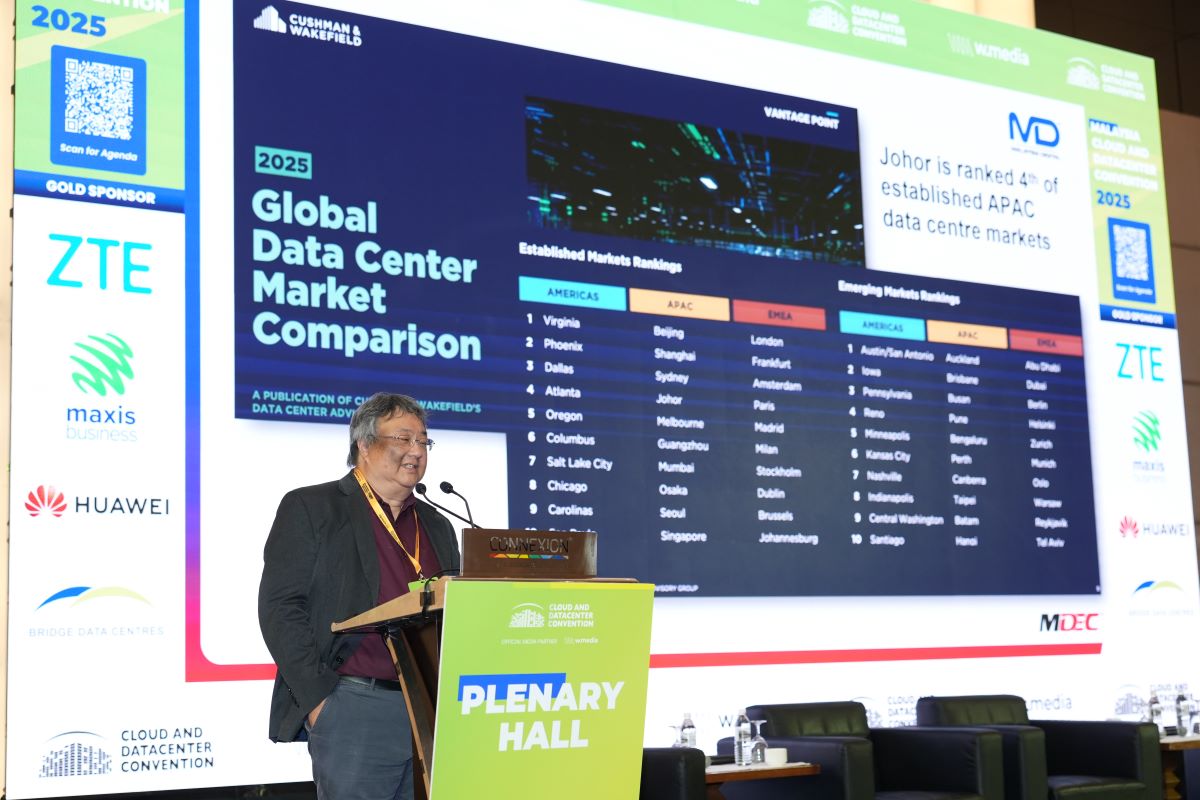The Malaysia Cloud & Datacenter Convention 2025 organised by w.media may be over but here are some of the highlights gathered from a select number of speakers.
Malaysia on track to be AI infra hub
Tan Tze Meng, Digital Infrastructure Expert, Malaysia Digital Economy Corporation (MDEC)
Tan Tze Meng is of the view that Malaysia has become one of the biggest artificial intelligence (AI) infrastructure hubs in the world based on the sharp increase in graphics processing unit (GPU) imports, a mind-blowing 3,400 per cent increase in April 2025 compared to 2023. What this signals is that the AI infrastructure is growing in Malaysia, which also explains the higher power demand coming from these AI data centers. Data centers have signed up with state utility Tenaga Nasional Berhad (TNB) for at least 5.7 GW of power supply against Malaysia’s total supply of 27 -29 GW with TNB being confident of generating enough electricity supply.
The biggest benefit [of data centers] to Malaysia is in the supply chain ecosystem where companies like engineering and construction company Gamuda are gaining technical expertise and experience in building world class data centers. Others are in the digitally transformed industries comprising companies offering digital services such as Grab, Lalamove, Boost, Bjak, etc, many of which are startups offering innovative new digital services.
The government and industry stakeholders need to collaborate to ensure guidelines implemented are workable. And finally, to address the brain drain of data center professionals to Singapore, perhaps increase Malaysia’s salary to nearer Singapore’s level. Some Singapore-based companies are already hiring Malaysians in Singapore at Singapore’s salary and then redeploying them back in Malaysia.
To stay ahead, plan early
Ai Leen Tang, Partner at Wong & Partners, a member firm of Baker McKenzie International
Ai Leen Tang gave some very timely advice for investors who are considering investing in data centers in Malaysia. With rules tightening up in Malaysia, investors would have to plan very much ahead. As the regulators require the data center operator to disclose a lot of information such as the size of data center, capacity, location, technology employed, end users, among others, as part of the information to be provided in support of their applications for approvals including the approval from the Data Centre Task Force (DCTF). This information would help the regulators ascertain the efficiency and sustainability of the data centers to be built and prevent speculative building. Also, the authorities now expect new data centers to have alternative energy solutions. As such, in order to meet the timelines, investors would need to work with the seller as early as possible, include some buffer in the timeline and start the process way ahead.
In short, investors are advised to ensure clear understanding of the approval process and regulations, engage early and regularly with local authorities, resource regulators, utility providers and the government. The planning stage is crucial – site selection, construction and facility design, and sustainability plans – getting them right is the key to avoiding unnecessary delay. Compliance is essential because no lawyer can defend you if that’s not done.
Connectivity keeping up
Peter Macaulay, Fiber architect, CelcomDigi Bhd
Peter Macaulay is of the view that we are currently living in a transition era as AI compute like GPU clusters from NVIDIA, Huawei and AMD are fundamentally changing the world. With the faster compute, connectivity would also have to be upgraded to keep up with the speed required. Hence, there is a need to upgrade the current fiber network. The expert expects fiber speeds to increase over the next five years.
Citing the example of CelcomDigi Berhad which will be testing 1600 Giga bits per second (1600 Gbps) or 1.6 Tera bits per second (1.6 Tbps) optical fiber transmission from January 2026, Macaulay explained that when deploying optical fiber infrastructure, they need to consider a future-proof design of at least 10 Tbps transmission speeds.
This also means most servers on optical switch will be upgraded to take advantage of the faster optical transmission rates and the accompanying reduced power made possible with fiber to the chip Co-Packaged Optics (CPO).
In terms of latency, the fiber architect revealed that we now have a new fiber called Hollow Core Fiber (HCF) which is constructed like a straw with a hollow inner core allowing the laser signal to be sent at the speed of light i.e. 299,792 km/second. This means it will now take 6.67 milliseconds in HCF to confirm a stock transaction, for example, from Singapore to Thailand spanning 2,000 km return trip time. The existing SMF (Single Mode Fiber) runs at 70 per cent the speed of light meaning it takes 9.52 milliseconds to do the same task.
“This 3-millisecond advantage will be important for the Financial Services Industry (FSI) such as online banking and online stock transactions which is highly reliant on speed to maximize returns on online transactions,” he explained.
In the last 40 years, we have used SMF (Single Mode Fiber) with a single core light path; now we have design choices of SMF, HCF and MCF (Multi-Core Fiber) with 4-core light paths in the same size cable all being addressed within the Malaysian Technical Standards Forum Berhad (MTSFB).



